ikfoundation.org
The IK Foundation
Promoting Natural & Cultural History
Since 1988


TEXTILE DYERS
– from the 1680s to 1910s in Whitby
Those who dyed textiles in Whitby worked under similar conditions throughout the 175-year period from the 1680s till the introduction of aniline dyes in 1856. Prior to this date, textile raw material, ready-spun yarn and woven fabric in wool, linen, silk or cotton were dyed with natural dyestuffs mostly from plant sources and, to a lesser extent, from substances derived from certain insects. It has not been possible to identify any specific local recipes or instructions – such things are seldom found in any locality since the art of dyeing required many specialist skills that had to be kept secret from rivals within the trade. The dyeing process was both manually and chemically complicated due to the various techniques necessary to fix the dyes on the yarn or cloth, and no less for the vital importance of choosing the right quality and quantity of dye to ensure an attractive and lasting colour.
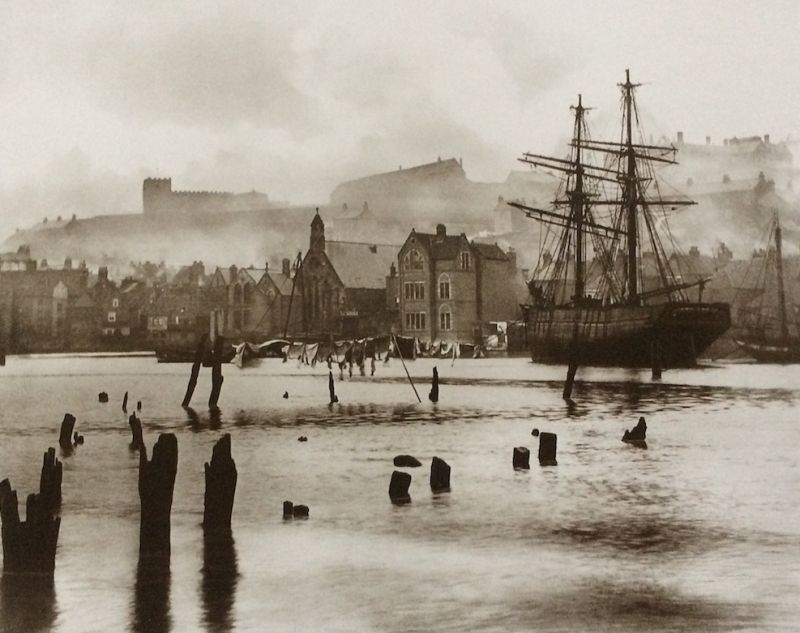 Judging by the addresses given by dyers in censuses, advertisements in the local paper and directories alike – many lived and worked along the streets and lanes close to the River Esk. Having constant access to water is crucial to the dyers’ daily work. This late 19th century photograph by Frank Meadow Sutcliffe gives a view of the river in the upper harbour and the eastern side of the old town where some of the dyers were active. (Courtesy: Whitby Museum, Photographic Collection, Sutcliffe, 25-44).
Judging by the addresses given by dyers in censuses, advertisements in the local paper and directories alike – many lived and worked along the streets and lanes close to the River Esk. Having constant access to water is crucial to the dyers’ daily work. This late 19th century photograph by Frank Meadow Sutcliffe gives a view of the river in the upper harbour and the eastern side of the old town where some of the dyers were active. (Courtesy: Whitby Museum, Photographic Collection, Sutcliffe, 25-44).Dyers can be traced back as far as 12 April 1686 when George Jackson drew up a Bond with the Whitby shipwright Henry Veysey, in which the dyer undertook to be ‘bound in £64.0.0. to observe the conditions and obligations contained in a bargain and sale of the same date’. A year later, he was dead, but his eldest son, also called George Jackson, continued the family connection with dyeing. The next name connected with this trade occurs in Cholmley’s lease book and is ‘Henry Martine near Bagdale’, who worked as a dyer for a good thirty years, as can be seen from the parish church registers, which record his burial in 1719. Whitby dyers can be followed in written documents continuously from then until 1833 through family baptisms and burials. Such registers inevitably provide a far from a complete list of those occupied locally with dyeing, despite the fact that their occupation was seldom mentioned before 1740 and virtually never between 1720 and 1735. Dyers may, for various reasons, have been active in the district for longer or shorter periods without their names appearing in any of these registers. Some may have had no family or moved away from Whitby before their deaths, while any female dyer would have been registered only under her husband’s profession or at her children’s baptisms. In addition to the dyer mentioned above, who died in 1719, the following persons were also recorded as dyers:
- 1741. Beckwith Newark (his own burial)
- 1742-1745. Ralph Ward (baptism of 2 children & burial of 1 child)
- 1749. Joseph Horseman (baptism of a child)
- 1751. Anthony Watson (burial of child)
- 1753-1772. Matthew Agar (baptism of 3 children & burial of 1 child)
- 1764-1779. George Fryer (baptism of 1 child & burial of 1 child)
- 1764-1785. John Booth (baptism of child and his own burial, 43 years old)
- 1788. Edward Roberson (baptism of a child)
- 1793-1813. John Booth (baptism of 6 children)
- 1796-1801. John Turner (baptism of 2 children)
- 1807. Coulson Watson (his own burial, 78 years old)
- 1822-1826. John Hall (baptism of 3 children)
- 1826-1833. Thomas Booth (baptism of 4 children)
As can be seen from this list, we can get some idea of the dyer’s period of activity from burials and baptisms or a combination of both, for anything from one year to several decades if the dyer in question had several children. It is interesting that the surname ‘Booth’ is recorded for three different men between 1764 and 1833, a period of seventy years. The first John Booth may have passed on his occupation to a son also called John and later to a grandson called Thomas. It is also possible that the Coulson Watson, who died at the advanced age of 78 in 1807, had worked as a dyer for the whole of an active life of fifty years or more, while the Anthony Watson mentioned in 1751 may have been a relative of Coulson Watson whose surname he shared.
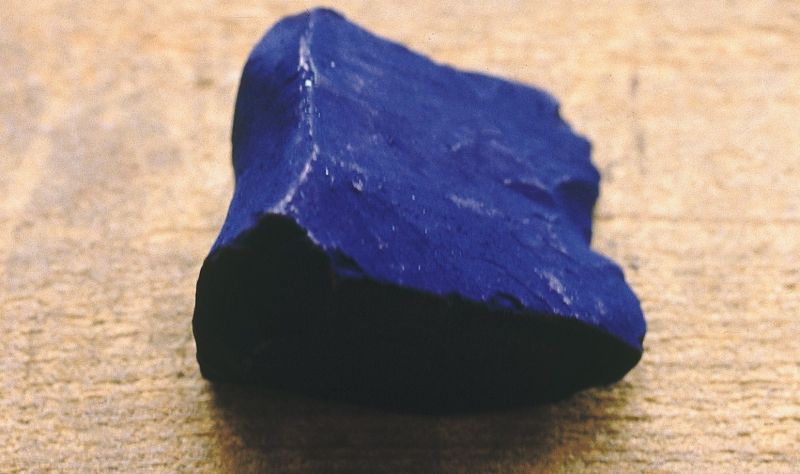 The hard-pressed fragment of a once larger indigo cube would have been ground to a fine powder before dyeing blue. An imported dye most sought after before synthetic dyeing, which also must have been used by Whitby dyers as one of few possible dyes for hardy blue colours (Private ownership). Photo: The IK Foundation.
The hard-pressed fragment of a once larger indigo cube would have been ground to a fine powder before dyeing blue. An imported dye most sought after before synthetic dyeing, which also must have been used by Whitby dyers as one of few possible dyes for hardy blue colours (Private ownership). Photo: The IK Foundation.Two directories from the early 19th century, for which there otherwise are only parish church registers give evidence of others active in the same occupation, now for the first time naming women. Baines’s Directory of 1823 includes:
‘Silk, &Co. Dyers
- Hall J. and clothes cleaner, Haggersgate
- Hunton Thomas, Haggersgate
- Ripley Wm. Well yard, Church Street’
While Pigot’s Directory, eleven years later in 1834, lists four new names:
‘Dyers
- Lyth Mary, Scate lane
- Milestone John, Silver St.
- Robinson Alexander, Church St.
- Snowdon Mary, Baxter Gate’
This material is too sparse to indicate whether the two women named in 1834 were unusual in the dyeing trade, but the census returns of 1841 to 1891 confirm that women continued to be active in this field. The 1841 census records Mary Lyth – already familiar from the 1834 directory – now living at Paddock and 60 years old. The other ‘Dyer’ in this census is Ann Milestone, a 75-year-old widow in Silver Street. She must have worked earlier with her husband, John Milestone, who appeared in the 1834 directory as active on the same street. On the other hand, the only dyer in the 1851 census is the 47-year-old widower John Stubbs, a ‘Dyer Master’. The title ‘Master’ presumably means that he dyed both cloth and yarn, employed one or more male or female assistants and had more advanced dyeing skills than a mere ‘Dyer’. Ten years later, again, only one person is recorded as connected with this occupation, a 68-year-old widow called Elizabeth Cowey who lived in Cliff Street and was active as a ‘Stuff-dyer’.
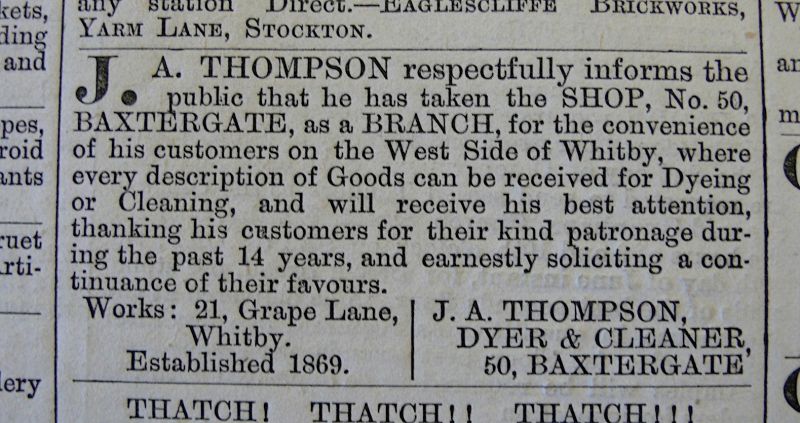 The 1871 census contains 28-year-old Joseph Thomson of Grape Lane as a ‘Dyer master’ together with Sarah Thomson, also 28, as ‘Dyer’s wife’, while Joseph Thomson was also said to have ‘one female employed’. The Thomson couple is not mentioned in the 1881 and subsequent censuses, but their business certainly continued to exist since ‘J.A. Thomson Whitby Steam Dye Works’ was advertised regularly in the Whitby Gazette. The firm had begun to operate in Grape Lane in 1869 and remained active until at least 1910. A ‘Notice of Removal’ to new premises in the same street in the spring of 1890 states, among other things, that ‘J.A.Thomson takes this opportunity of returning his sincere thanks to all his customers for their kind patronage during the last 20 years and hopes to merit a continuance of their favour and support... Established 1869’. Illustrated in the local paper in June 1885. (Collection: Whitby Museum, Library & Archive). Photo: Viveka Hansen, The IK Foundation.
The 1871 census contains 28-year-old Joseph Thomson of Grape Lane as a ‘Dyer master’ together with Sarah Thomson, also 28, as ‘Dyer’s wife’, while Joseph Thomson was also said to have ‘one female employed’. The Thomson couple is not mentioned in the 1881 and subsequent censuses, but their business certainly continued to exist since ‘J.A. Thomson Whitby Steam Dye Works’ was advertised regularly in the Whitby Gazette. The firm had begun to operate in Grape Lane in 1869 and remained active until at least 1910. A ‘Notice of Removal’ to new premises in the same street in the spring of 1890 states, among other things, that ‘J.A.Thomson takes this opportunity of returning his sincere thanks to all his customers for their kind patronage during the last 20 years and hopes to merit a continuance of their favour and support... Established 1869’. Illustrated in the local paper in June 1885. (Collection: Whitby Museum, Library & Archive). Photo: Viveka Hansen, The IK Foundation.According to notices of the period in the same newspaper R. H. Pomfret of 40 Flowergate sent cloth to be dyed to ‘Pomfret’s Dye works Sunderland’ during 1882 (he was active in Whitby at least 1882- 1912). But R. H. Pomfret’s name is not found in any Whitby census, which must mean that he did not live in the town. The 1891 census lists 51-year-old Ann Marie Ripley as living as a ‘Dyer’s Shopwoman’ at 40 Flowergate. This is the address of R. H. Pomfret’s business advertisements during the 1880s, so Ann Marie Ripley was presumably employed in Pomfret’s shop or lived nearby so as to be able to look after it. However, the censuses of 1901 and 1911 contain nobody who claimed any connection with dyeing.
The two Whitby directories, dated 1890 and 1901, do list the Pomfret and Thomson firms as active in this connection. Bulmer’s Directory of 1890 contains: ‘Dyers. Pomfret Ralph, 40 Flowergate’ and ‘Thomson J.A. 23 Grape Lane’. Whilst Cook’s Directory of 1901 lists: ‘Dyers and Cleaners. Pomfret, R.H & Son, 40 Flowergate’ and ‘Thomson J.A. 23 Grape Lane; steam dye works, Tate Hill, Church Street’.
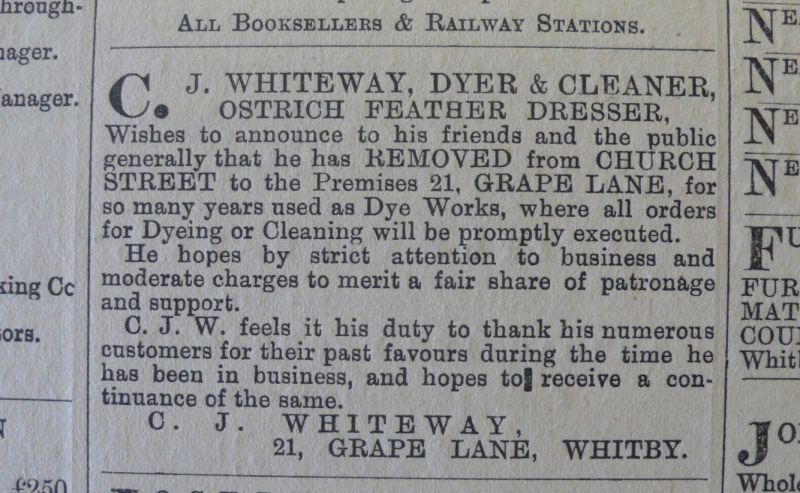 Another Whitby dyer informing his costumers about a move of the business and ongoing dyeing services – including the more unusual sideline of ‘Ostrich Feather Dresser’. Whitby Gazette, 16 August 1889. (Collection: Whitby Museum, Library & Archive). Photo: Viveka Hansen, The IK Foundation.
Another Whitby dyer informing his costumers about a move of the business and ongoing dyeing services – including the more unusual sideline of ‘Ostrich Feather Dresser’. Whitby Gazette, 16 August 1889. (Collection: Whitby Museum, Library & Archive). Photo: Viveka Hansen, The IK Foundation.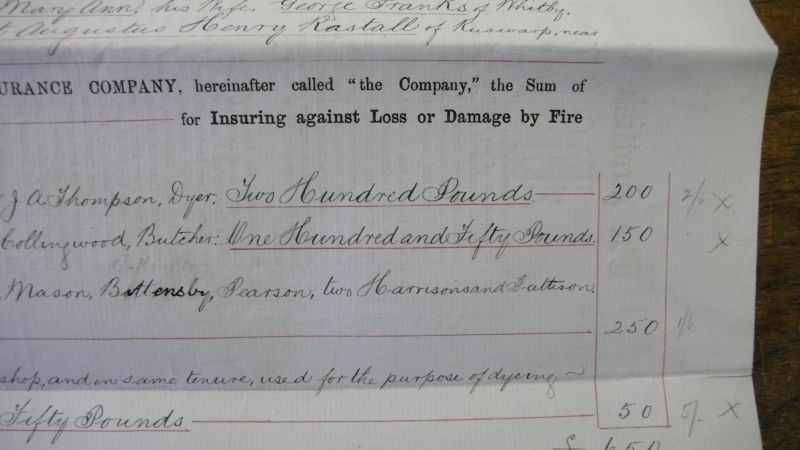 Fire Insurance Policy J. A. Thomson 1887. (Collection: Whitby Museum, Library & Archive, 0035/4/14). Photo: Viveka Hansen, The IK Foundation.
Fire Insurance Policy J. A. Thomson 1887. (Collection: Whitby Museum, Library & Archive, 0035/4/14). Photo: Viveka Hansen, The IK Foundation.The previously mentioned J.A.Thomson also appears on this Fire Insurance Policy dated 8 July 1887. The dyer’s share of the insurance for Grape Lane amounts to £200 ‘for Insuring against Loss or Damage by Fire’. This was undoubtedly an essential insurance for a dyer to take out since the process of dyeing involved regularly heating water in large pots or other receptacles over an open fire to ensure that the cloth or yarn to be dyed would absorb the colouring agent properly.
Sources:
- Hansen, Viveka, The Textile History of Whitby 1700-1914 – A lively coastal town between the North Sea and North York Moors, London & Whitby 2015. (pp. 288-291).
- The National Archive (Census 1911, Whitby. Digital source).
- Whitby Museum, Library & Archive, Whitby Lit. & Phil. (Including Whitby Gazette 1855-1914 & Parish Church Registers, Whitby Directories & Fire Insurance documents).
- Whitby Museum, Photographic- & Costume Collections. Whitby Lit. & Phil. (Including studies of photographs and colours on preserved garments).
- Whitby, North Yorkshire County Library (Census 1881-1901 microfilm).
More in Books & Art:
Essays
The iTEXTILIS is a division of The IK Workshop Society – a global and unique forum for all those interested in Natural & Cultural History from a textile Perspective.
Open Access essays, licensed under Creative Commons and freely accessible, by Textile historian Viveka Hansen, aim to integrate her current research, printed monographs, and earlier projects dating back to the late 1980s. Some essays feature rare archive material originally published in other languages, now available in English for the first time, revealing aspects of history that were previously little known outside northern European countries. Her work also explores various topics, including the textile trade, material culture, cloth manufacturing, fashion, natural dyeing, and the intriguing world of early travelling naturalists – such as the "Linnaean network" – viewed through a global historical lens.
For regular updates and to fully utilise iTEXTILIS' features, we recommend subscribing to our newsletter, iMESSENGER.
been copied to your clipboard




– a truly European organisation since 1988
Legal issues | Forget me | and much more...
You are welcome to use the information and knowledge from
The IK Workshop Society, as long as you follow a few simple rules.
LEARN MORE & I AGREE







